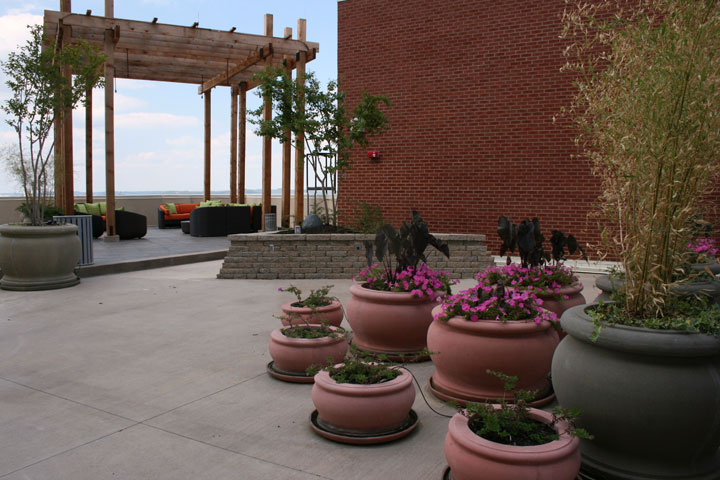Table of Contents
Do you want to get the most out of your outdoor spaces? A patio makes outdoor living comfortable and pleasant. It completes our home–like having an extra room outside. Patios are also one of the landscaping features that offer a significant bang for your buck in terms of resale value. According to a 2008 study, adding a patio can bump up your home value by more than 12 percent. And the best part is, you’ll enjoy it like crazy until it’s time to sell.
What Material Is Best for a Patio?
There are plenty of options when deciding which material to use for a new patio. Some of the factors to consider include looks, style, durability, and cost. Here’s a breakdown of the most popular materials with benefits and drawbacks:
- Brick is one of the most honest and durable building materials. It’s simply formed and fired clay, and it’s at the top of the list for a classy, elegant appearance. The regular shape and color of brick are ideal for more intricate patterns. Genuine brick is pricier than some other materials, but it’s very durable. As a natural material, it tends to attract moss more than some alternatives. Washing and sealing regularly can keep brick pavers looking their best.
- Stone pavers are made from natural stone (often granite) cut into paver shape. They’re high-quality, very durable (even more than brick), and gorgeous. Stone pavers are one of the priciest patio materials but can last a lifetime if well maintained.
- Concrete pavers allow the esthetic advantages and durability of pavers at a lower price point than stone or brick. They’re available in a range of colors and shapes, including hexagonal, squares, rectangles or shaped like natural stone. Many concrete pavers come in interlocking patterns, so minimal mortar or sand is required to hold them in place. They’re easy to maintain, but color pigments tend to fade over the years. Quality tends to vary with concrete pavers, so it’s especially important to choose a reputable brand for durability.
- Flagstone is made of flat stones and is a patio classic thanks to its lovely irregular shapes and attractive natural colors from blue to red to neutral beige. Flagstone is water-permeable to a certain degree, so there’s less water runoff than with some other materials. However, this can also make it prone to water damage.
- Ceramic or terracotta tiles are other options for patios. These materials are gorgeous but tend to be pricey and can be slippery in a humid environment like ours. However, they can be a good fit for smaller patios in some landscapes.
- Stamped concrete is a popular, low-cost option for patios. It can be stained in a range of colors and even designed to look like natural stone or slate. Concrete can also be surfaced with pebbles for an attractive, non-slip surface. Concrete is sturdy and low maintenance but more prone to cracking than some other materials. It won’t last as long as some of the more expensive options.
What Is the Best Material for Filling the Gaps
 For pavers and flagstone, keep in mind that there are different fillers for the joints between the materials. These include mortar, concrete, loose sand, or crushed stone. For pavers, masonry can provide more stability, but sand is a beloved traditional material that offers an appealing rustic look. Polymeric sand has ingredients that harden to make it more weed resistant and keep pavers in place. For flagstone, concrete tends to be the filler of choice. Natural stones need more stability because of their larger size, and concrete prevents these large, flat stones from heaving due to weather and wear.
For pavers and flagstone, keep in mind that there are different fillers for the joints between the materials. These include mortar, concrete, loose sand, or crushed stone. For pavers, masonry can provide more stability, but sand is a beloved traditional material that offers an appealing rustic look. Polymeric sand has ingredients that harden to make it more weed resistant and keep pavers in place. For flagstone, concrete tends to be the filler of choice. Natural stones need more stability because of their larger size, and concrete prevents these large, flat stones from heaving due to weather and wear.
What Should I Know When Building a Patio?
A great patio starts with a good foundation. Whatever material you choose, a solid base is essential. Without the right support, your patio may turn out uneven and attractive to weeds.
- Make calls and fill out paperwork related to utility lines before you dig.
- Measure and dig out the perimeter accurately.
- Add landscape fabric and a gravel base followed by a sand-base layer before installing your patio material to provide stability.
- Working with a professional landscaper is the best way to make sure your patio is stable and attractive.
Building a Patio? Call the Pros
The goal is a patio you’ll want to live on every day. This means a solid base, high-quality materials, and top-notch installation. That’s why calling on an experienced landscaper to design and build your patio makes so much sense. You want hardscaping that’s easy to walk on, visually appealing, and long-lasting. You also want to create a sense of harmony between your hardscaping and your landscaping: the transition from patio to yard should be smooth and beautiful. Acer Landscape Services is a one-stop contractor who can do it all, from a perfect patio to stellar landscaping. This year, a comfortable and attractive outdoor space is more important than ever. With the right partner, you can create an environment where you can cook, dine, play, and relax for years to come.



